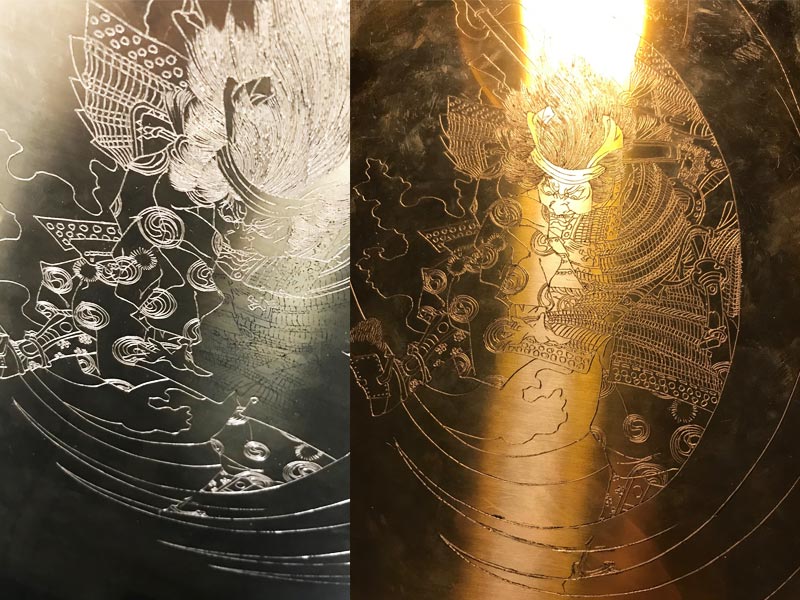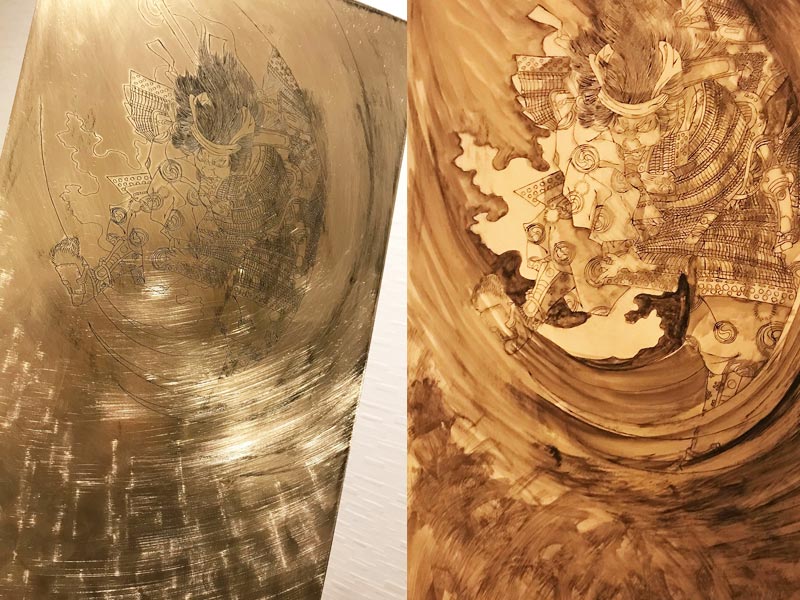Rewrite from the original picture with only lines and go to line engraving.
元絵から線のみで書き直して、すじ彫りへ
今回は墨入れで大きく陰影を付けるのと、真鍮版自体が薄い(10mm)為、均等な線のすじ彫りにしています。
40cm×20cmくらいのサイズなので、10mm厚でも壁に飾る事を考えると結構重量はあります。
English translation
This time, since the ink is used to add large shadows, and the brass plate itself is thin (10 mm), even lines are carved.
It's about 40cm x 20cm in size, so even if it's 10mm thick, it's quite heavy considering it's hanging on the wall.
Hairline, inking, coloring, finishing.
ヘアライン、墨入れ、色付け、仕上げへ



すじ彫りが終わったら軽くバリ取りを行い、ヘアラインを入れていきます(今回は400-600番)。
今回は実験的にヘアラインの上から色付けを行う為、墨入れ後にヘアラインが消えない様に
ヤスリがけをしています、下の方にはリーフ模様を入れてあり、画像ではちょっと判りにくいですが
色付けの下にしっかり存在しており光の加減で様々な表情を見せてくれます。
ホワイトとアンバーのライティングで撮影した為、同じ物とは思えない程に色が違いますが
光の色や角度によって全く違う表情になるところが彫金アートの魅力かと思います。
書き忘れていましたが、お題は 新形三十六怪撰 「布引滝悪源太義平霊討難波次郎」 月岡芳年 です。
個人的には、歌川国芳、月岡芳年、河鍋暁斎、が最も好きな浮世絵師ですね、
今見ても発想力や構図など色々と勉強になります。
English translation
After carving the lines, deburr lightly and add a hairline (No. 400-600 this time).
This time, I will be coloring from the top of the hairline as an experiment, so I sanded the hairline so that it would not disappear after the ink was applied.
It exists firmly under the coloring and shows various expressions depending on the amount of light.
Because I shot with white and amber lighting, the colors are so different that I can't believe it's the same thing.
I think the charm of metal engraving art is that it looks completely different depending on the color and angle of the light.
I forgot to write it down, but the subject is Shingata Thirty-six Monsters Selection ``Nunobiki no Taki Akugenta Yoshihira no Rei Nanba Jiro wo Utsu'' Yoshitoshi Tsukioka.
Personally, Kuniyoshi Utagawa, Yoshitoshi Tsukioka, and Kyosai Kawanabe are my favorite ukiyo-e artists.
Even now, I can learn a lot about ideas and composition.

